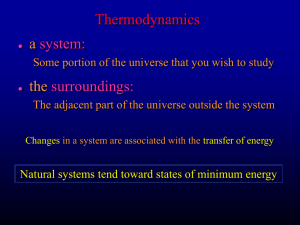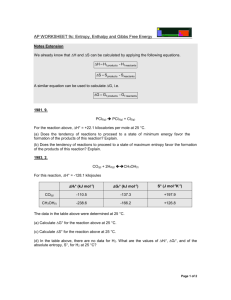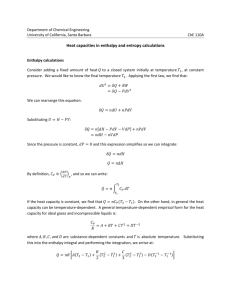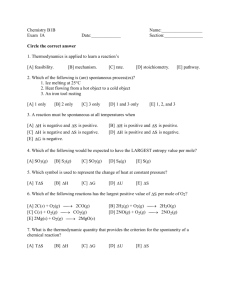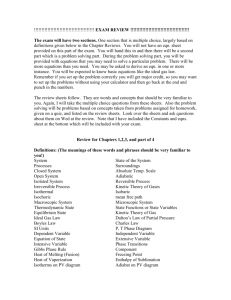Unit 9 Thermodynamics Homework
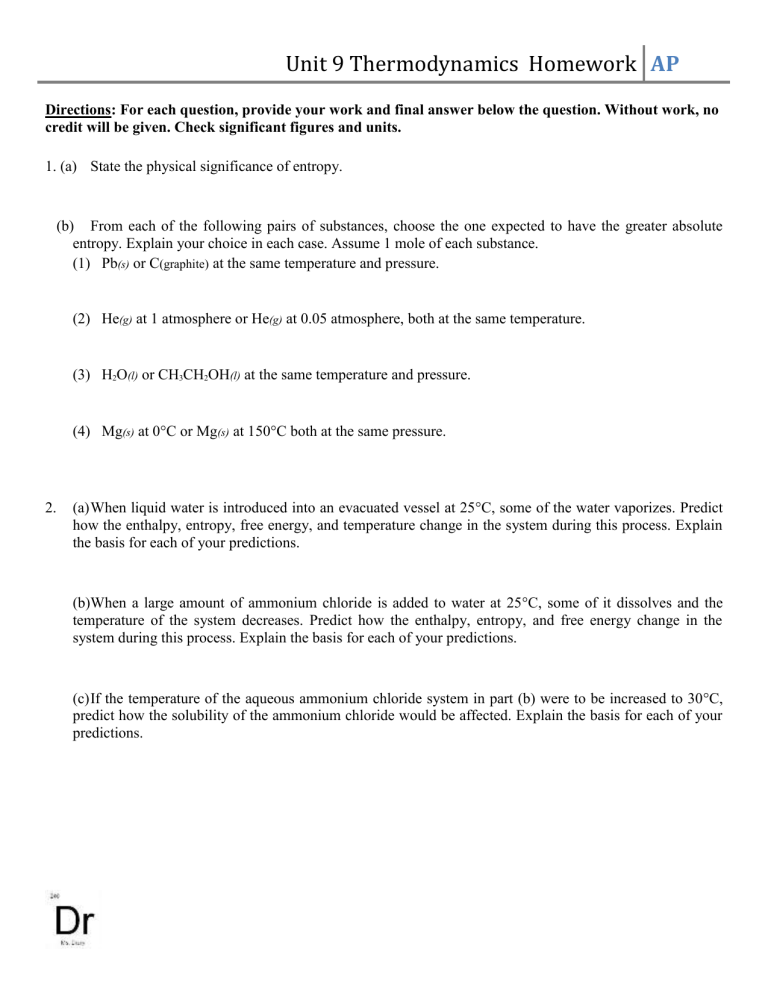
Unit 9 Thermodynamics Homework AP
Directions: For each question, provide your work and final answer below the question. Without work, no credit will be given. Check significant figures and units.
1. (a) State the physical significance of entropy.
(b) From each of the following pairs of substances, choose the one expected to have the greater absolute entropy. Explain your choice in each case. Assume 1 mole of each substance.
(1) Pb
(s)
or C (graphite) at the same temperature and pressure.
(2) He
(g)
at 1 atmosphere or He
(g)
at 0.05 atmosphere, both at the same temperature.
(3) H
2
O
(l)
or CH
3
CH
2
OH
(l)
at the same temperature and pressure.
(4) Mg
(s)
at 0
C or Mg
(s)
at 150
C both at the same pressure.
2. (a) When liquid water is introduced into an evacuated vessel at 25
C, some of the water vaporizes. Predict how the enthalpy, entropy, free energy, and temperature change in the system during this process. Explain the basis for each of your predictions.
(b)When a large amount of ammonium chloride is added to water at 25
C, some of it dissolves and the temperature of the system decreases. Predict how the enthalpy, entropy, and free energy change in the system during this process. Explain the basis for each of your predictions.
(c) If the temperature of the aqueous ammonium chloride system in part (b) were to be increased to 30
C, predict how the solubility of the ammonium chloride would be affected. Explain the basis for each of your predictions.
Unit 9 Thermodynamics Homework AP
Substance
C
C
2
Cl
2
H
2
H
HCl
4
5
Cl
(g)
Cl
(g)
2
(g)
(g)
G
f
298 K, kJ mol
-80.3
-60.5
-95.3
0
-1 Bond
C-H
C-C
C-Cl
Cl-Cl
H-Cl
Energy, kJ mol -1
414
347
377
243
431
3. The tables above contain information for determining thermodynamic properties of the reaction below.
C
2
H
5
Cl
(g)
+ Cl
2
(g)
C
2
H
4
Cl
2
(g)
+ HCl
(g)
(a) Calculate the
H
for the reaction above, using the table of average bond dissociation energies.
(b) Calculate the
S
for the reaction at 298 K, using data from either table as needed.
(c) Calculate the value of K eq
for the reaction at 298 K.
(d) What is the effect of an increase in temperature on the value of the equilibrium constant? Explain your answer.
4.
Substance
C
(s)
H
2
(g)
C
2
H
5
OH
(l)
H
2
O
(l)
Enthalpy of Absolute
Combustion,
H
Entropy, S
(kiloJoules/mol) (Joules/mol-K) .
-393.5
-285.8
-1366.7
- -
5.740
130.6
160.7
69.91
(a) Write a separate, balanced chemical equation for the combustion of each of the following: C
(s)
, H
2
(g)
, and C
2
H
5
OH
(l)
. Consider the only products to be CO
2
and/or H
2
O
(l)
.
(b)In principle, ethanol can be prepared by the following reaction:
2 C
(s)
+ 2 H
2
(g)
+ H
2
O
(l)
C
2
H
5
OH
(l)
Calculate the standard enthalpy change,
H
, for the preparation of ethanol, as shown in the reaction above.
(c) Calculate the standard entropy change,
S
, for the reaction given in part (b).
Unit 9 Thermodynamics Homework AP
(d)Calculate the value of the equilibrium constant at 25
C for the reaction represented by the equation in part (b).
Directions: Read the passage below and answer the summary questions that follow in complete sentences.
Rubber is composed of random-length chains of polymerized isoprene molecules. The poly(isoprene) chains are held together partly by weak intermolecular forces, but are joined at irregular intervals by covalent disulfide bonds so as to form a network. The intermolecular forces between the chain fragments tend to curl them up, but application of a tensile force can cause them to elongate. The disulfide cross-links prevent the chains from slipping apart from one another, thus maintaining the physical integrity of the material. Without this crosslinking, the polymer chains would behave more like a pile of spaghetti.
This image is adapted from one intended to show the structure of the rubber-like protein elastin, which is found in many organisms, including humans.
The ability of rubber bands and other elastic substances to undergo a change in physical dimensions in response to a change in the applied stretching force is subject to the same laws of thermodynamics as any other physical process. You can investigate this for yourself:
1.
Hold a rubber band (the thicker the better) against your upper lip, and notice how the temperature changes when the band is stretched, and then again when it is allowed to contract. Use the results of this observation to determine the signs of enthalpy, entropy, and Gibbs free energy changes for the process.
2.
How will the tendency of the stretched rubber to contract be changes if the temperature is raised? (will S be more positive or negative?)


